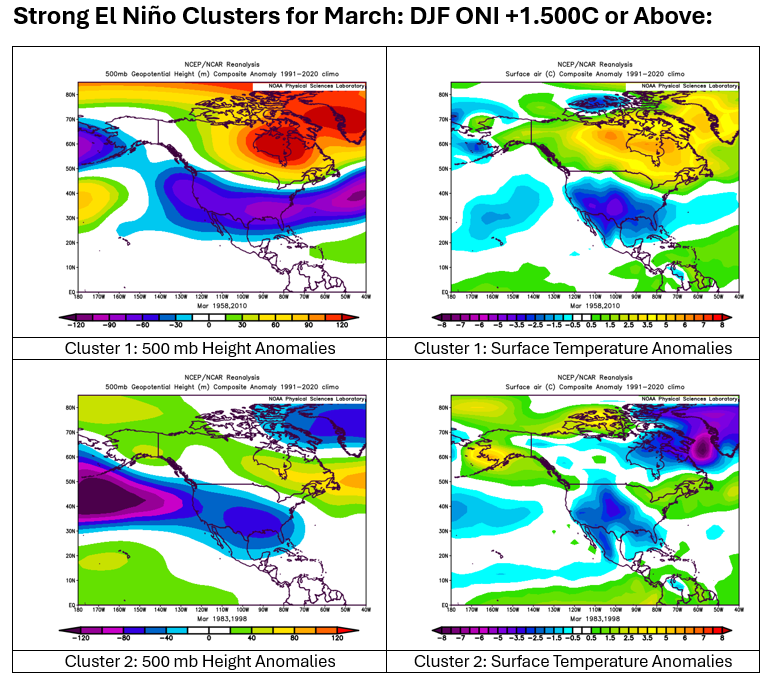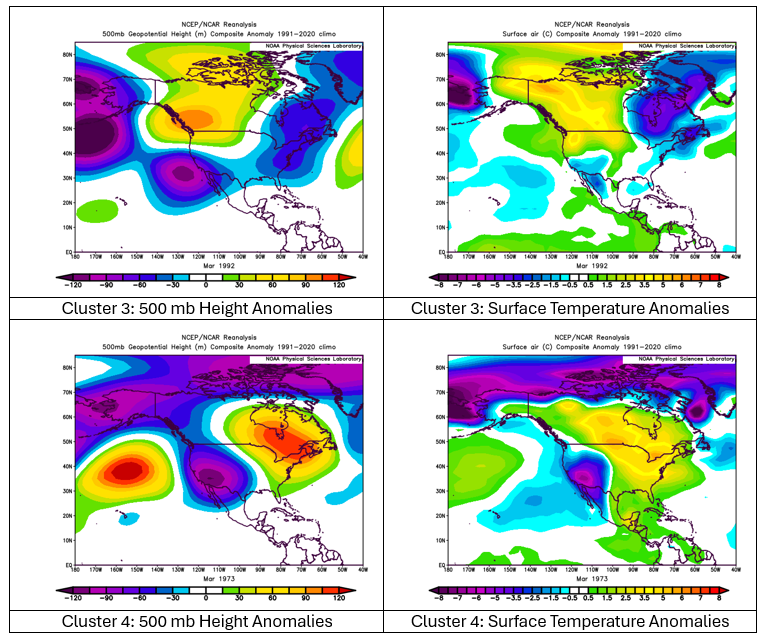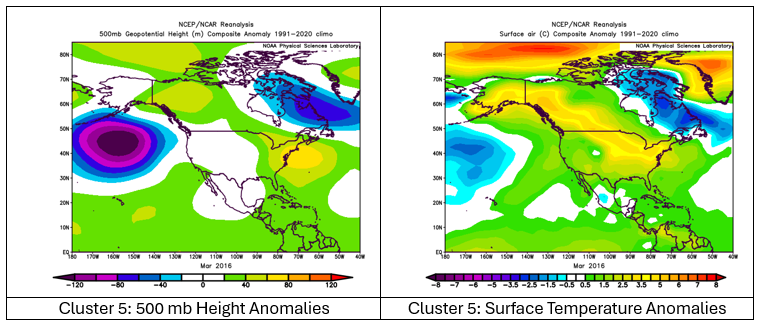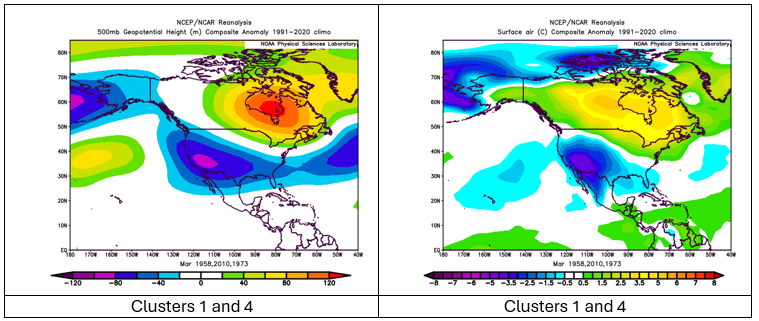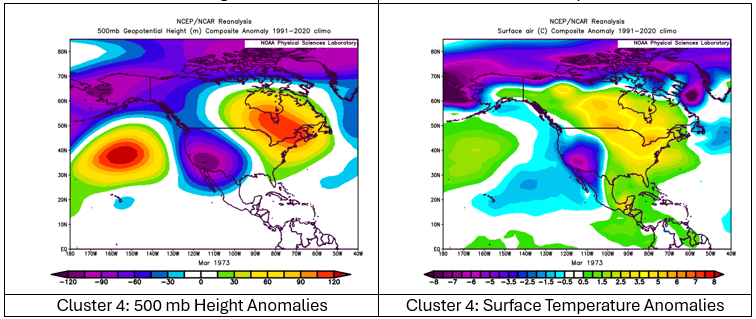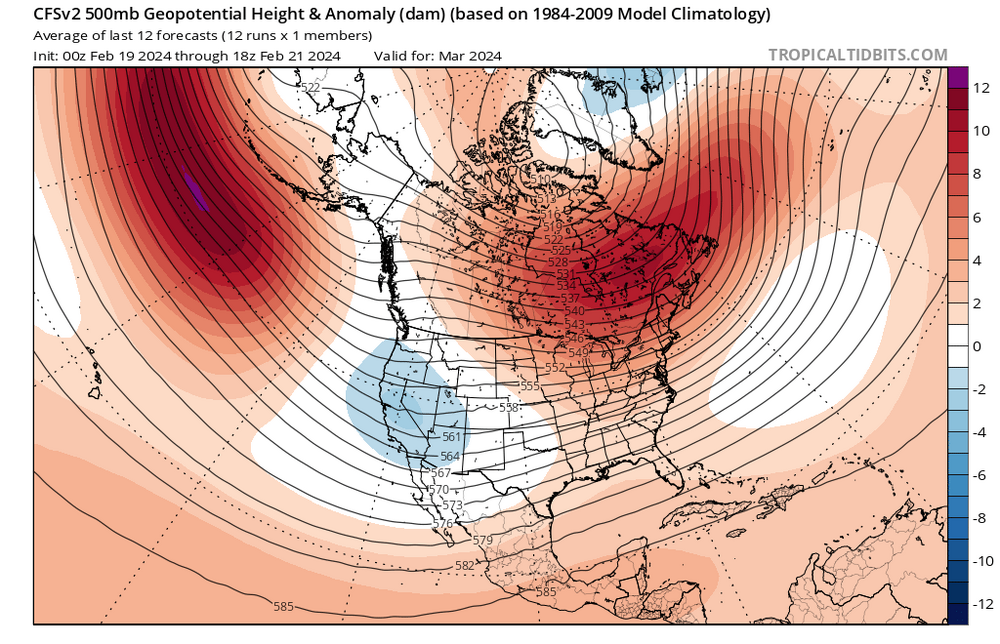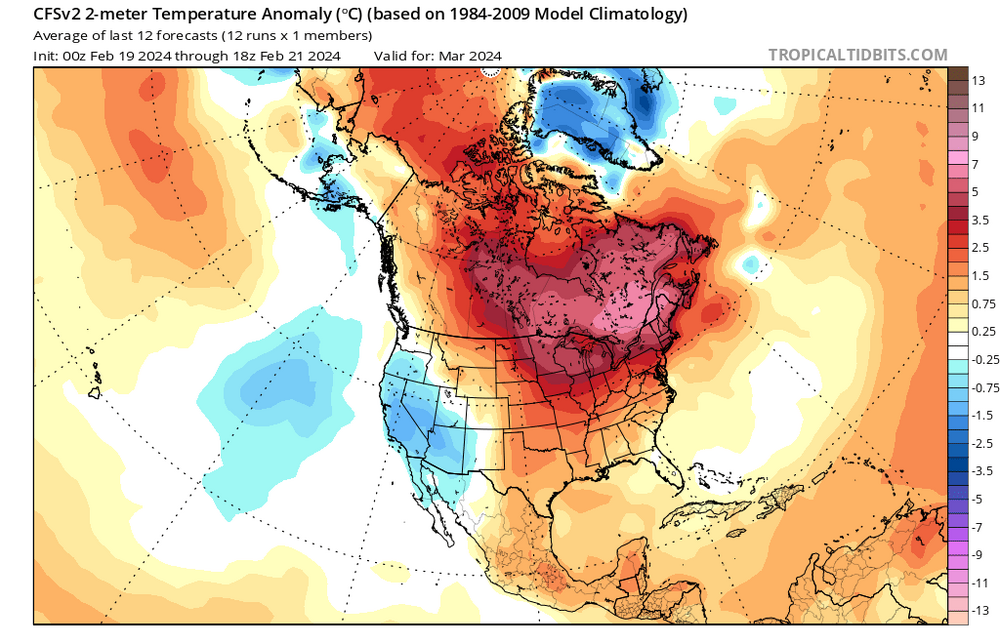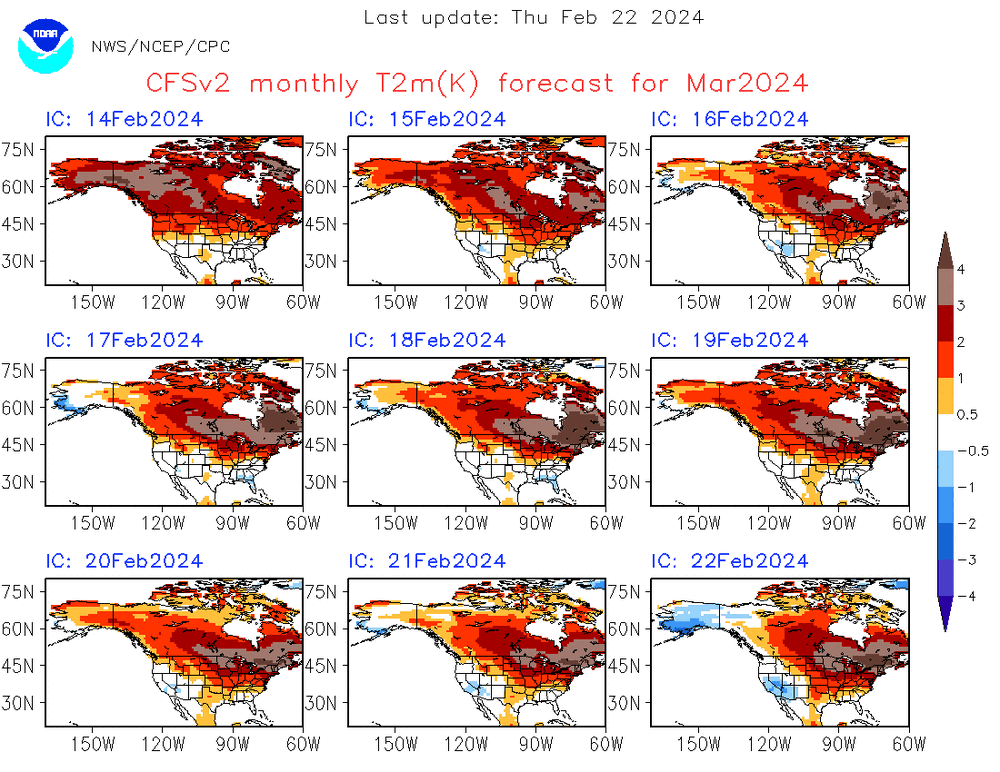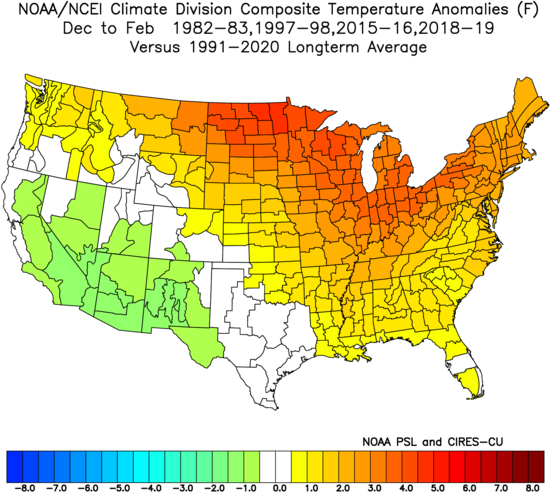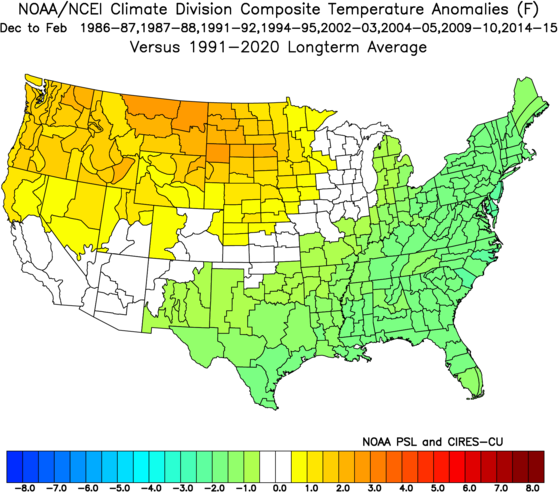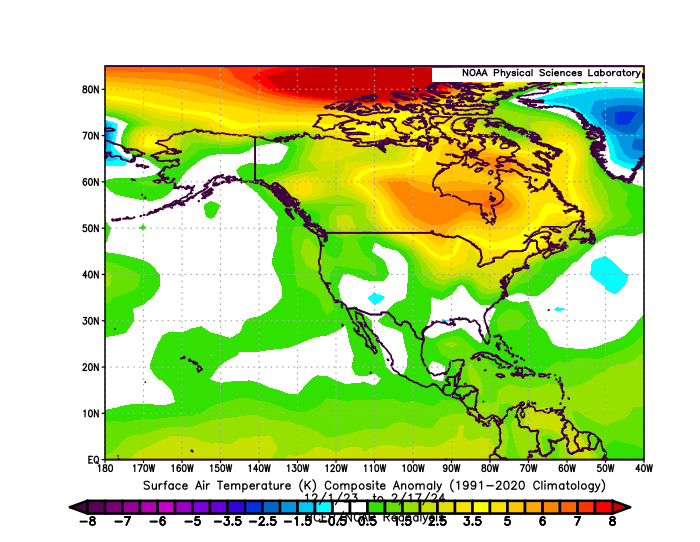-
Posts
22,984 -
Joined
Content Type
Profiles
Blogs
Forums
American Weather
Media Demo
Store
Gallery
Everything posted by donsutherland1
-
Tomorrow will be another chilly day. However, the cold will rapidly depart from the region by Monday. Afterward, temperatures will quickly rebound. Afterward, temperatures will remain generally above normal through the remainder of February. The potential exists for the closing days of February to wind up much warmer than normal. Little or no additional snowfall is likely in the New York City or Philadelphia areas through the remainder of February. March will likely begin with generally unseasonable warmth through the first 7-10 days of the month. No significant snowfall appears likely in the northern Middle Atlantic region during that time. Overall, March will likely be warmer than normal. The ENSO Region 1+2 anomaly was +1.1°C and the Region 3.4 anomaly was +1.5°C for the week centered around February 14. For the past six weeks, the ENSO Region 1+2 anomaly has averaged +0.95°C and the ENSO Region 3.4 anomaly has averaged +1.72°C. A basinwide El Niño event is ongoing. The ongoing El Niño event will continue to fade during March. Neutral conditions could develop during the spring. The SOI was +2.02 today. The preliminary Arctic Oscillation (AO) was +1.744 today. On February 22 the MJO was in Phase 5 at an amplitude of 0.343 (RMM). The February 21-adjusted amplitude was 0.126 (RMM). Based on sensitivity analysis applied to the latest guidance, there is an implied near 100% probability that New York City will have a warmer than normal February (1991-2020 normal). February will likely finish with a mean temperature near 39.9° (4.0° above normal). Winter 2023-2024 is on course to finish with a seasonal mean temperature of 40.4°-40.7°. That would rank the current winter among the ten warmest on record in New York City. It would also mark the second time when two consecutive winters have ranked among the top ten in terms of warmth. Winters 2015-2016 and 2016-2017 are currently the only two such winters to rank among the ten warmest on record. Winters 2022-2023 and 2023-2024 will become the first time on record that New York City has seen two consecutive winters with 40.0° or above mean temperatures. Since 1869, there have been six winters with a mean temperature of 40.0° or above. Five have occurred since 2000.
-
It's probably not too surprising. The weeklies have little or no skill beyond two weeks.
-
1996-97 and 1997-98. 3 out of 5 winters when 1994-95 is included.
-
With little or no additional snowfall likely in New York City through the remainder of February, the probability that Central Park will see its first case of two consecutive winters with less than 10.0" seasonal snowfall has increased. Below are the numbers for select snowfall amounts through February. The highlighted row indicates where Winter 2023-2024 will very likely stand when February concludes.
-
This weekend will feature a brief push of cooler air into the region. The cold shot will be shortlived. Afterward, temperatures will quickly rebound. Afterward, temperatures will remain generally above normal through the remainder of February. The potential exists for the closing days of February to wind up much warmer than normal. Little or no additional snowfall is likely in the New York City or Philadelphia areas through the remainder of February. March will likely begin with generally unseasonable warmth through the first 7-10 days of the month. No significant snowfall appears likely in the northern Middle Atlantic region during that time. The ENSO Region 1+2 anomaly was +1.1°C and the Region 3.4 anomaly was +1.5°C for the week centered around February 14. For the past six weeks, the ENSO Region 1+2 anomaly has averaged +0.95°C and the ENSO Region 3.4 anomaly has averaged +1.72°C. A basinwide El Niño event is ongoing. The ongoing El Niño event will continue to fade. The SOI was -3.75 today. The preliminary Arctic Oscillation (AO) was +2.171 today. On February 21 the MJO was in Phase 5 at an amplitude of 0.126 (RMM). The February 20-adjusted amplitude was 0.432 (RMM). Based on sensitivity analysis applied to the latest guidance, there is an implied near 100% probability that New York City will have a warmer than normal February (1991-2020 normal). February will likely finish with a mean temperature near 39.9° (4.0° above normal). Winter 2023-2024 is on course to finish with a seasonal mean temperature of 40.5°-40.7°. That would rank the current winter among the ten warmest on record in New York City. It would also mark the second time when two consecutive winters have ranked among the top ten in terms of warmth. Winters 2015-2016 and 2016-2017 are currently the only two such winters to rank among the ten warmest on record. It would also be the first time on record that New York City has seen two consecutive winters with 40.0° or above mean temperatures. Since 1869, there have been six winters with a mean temperature of 40.0° or above. Five have occurred since 2000.
-
A lot more warming.
-
The real trigger would sufficient evaporation of the oceans. That’s currently not likely. A good paper: https://www.aanda.org/articles/aa/full_html/2023/12/aa46936-23/aa46936-23.html
-
CO2 reacts with water to form carbonic acid. As carbonic acid concentrations rise, oceans become more acidic, as is currently occurring.
-
On humanity's present course, the risk of an anoxic ocean event will increase, especially later this century and beyond.
-
A milder pattern is now in place. Aside from a brief push of cooler air during the coming weekend, temperatures should remain generally above normal through the remainder of February. The potential exists for the closing days of February to wind up much warmer than normal. Little or no additional snowfall is likely in the New York City or Philadelphia areas through the remainder of February. March will likely begin with generally unseasonable warmth through the first 7-10 days of the month. No significant snowfall appears likely in the northern Middle Atlantic region during that time. The ENSO Region 1+2 anomaly was +1.1°C and the Region 3.4 anomaly was +1.5°C for the week centered around February 14. For the past six weeks, the ENSO Region 1+2 anomaly has averaged +0.95°C and the ENSO Region 3.4 anomaly has averaged +1.72°C. A basinwide El Niño event is ongoing. The ongoing El Niño event will continue to fade. The SOI was -0.96 today. The preliminary Arctic Oscillation (AO) was +2.568 today. On February 20 the MJO was in Phase 8 at an amplitude of 0.432 (RMM). The February 19-adjusted amplitude was 0.808 (RMM). Based on sensitivity analysis applied to the latest guidance, there is an implied near 100% probability that New York City will have a warmer than normal February (1991-2020 normal). February will likely finish with a mean temperature near 39.9° (4.0° above normal). Winter 2023-2024 is on course to finish with a seasonal mean temperature of 40.4°-40.7°. That would rank the current winter among the ten warmest on record in New York City. It would also mark the second time when two consecutive winters have ranked among the top ten in terms of warmth. Winters 2015-2016 and 2016-2017 are currently the only two such winters to rank among the ten warmest on record. It would also be the first time on record that New York City has seen two consecutive winters with 40.0° or above mean temperatures. Since 1869, there have been six winters with a mean temperature of 40.0° or above. Five have occurred since 2000.
-
These are all good points. Of course, we'll have to see how the MJO actually progresses.
-
The CFSv2 is now moving into its skillful range. Its March outlook has shifted toward Cluster 4 of the strong ENSO cases provided previously. Cluster 4 is the PDO- case from 1973. Previously, the CFSv2 had favored a warmer version of Cluster 1, which had warmth across the northern tier of the CONUS. CFSv2 500 mb Forecast: CFSv2 Temperature Forecast: Evolution of CFSv2 Forecasts: Key Takeaways: A warmer than normal March continues to be favored in the Northeast, including the Middle Atlantic and southern New England regions (majority of ENSO clusters and evolving CFSv2 guidance) Based on strong ENSO climatology, the March 11-24 period might offer the remaining window of opportunity for some cold and/or snow. The latest ECMWF weekly guidance has the coldest anomalies relative to normal in the closing 2 weeks of the month, but the weeklies lack skill at that timeframe. Until one is closer to the forecast period and there is both skill and consensus on the guidance, it makes sense to defer to climatology. The potential stratospheric warming event could be a "final warming" event. Such events typically do not have the same response as other stratospheric warming events. ENSO Cluster 4 (PDO-) favors below normal snowfall in the Northeast. Based on the latest guidance, the probability that Central Park could fail to reach 10" snow for a record second consecutive winter has increased.
-
Although a cooler period developed on February 13th, it ended today. I had expected that it could extend into the first week of March. In addition, New York City saw no readings with lows in the teens (the coldest weather was warmer than I had expected). Central Park saw a light and moderate snowfall. JFK Airport saw a moderate and significant snowfall. LaGuardia Airport experienced two moderate snowfalls. The cooler period ended largely in line with strong ENSO climatology in February, which often has seen the closing 7-10 days wind up warmer to much warmer than normal. The latest ECMWF weeklies see warmer than normal conditions running into at least the second week of March. Strong ENSO climatology has typically seen a cool-down before mid-March that continues just past the Spring Equinox. Afterward, it turns warmer. Given lack of model skill at such distant timeframes, the outcome beyond the first week of March remains speculative. Despite a possible stratospheric warming event, it's entirely plausible that the Polar Vortex could remain over Eurasia and cooler weather could be relatively short-lived. All in all, the odds may somewhat lean toward a warmer than normal March.
-
A milder pattern is now developing. Aside from a brief push of cooler air during the coming weekend, temperatures should remain generally above normal through the remainder of February. The potential exists for the closing days of February to wind up much warmer than normal. Little or no additional snowfall is likely in the New York City or Philadelphia areas through the remainder of February. Overall, a very warm winter is nearing an end. As warm as the winter has been in the New York City area, it has been even warmer in the Great Lakes Region and Northern Plains. Fargo is on track to beat its old winter record by more than 4°. Moreover, Winter 2023-24 could be Fargo's first winter where two months saw the temperature fail to drop below 0°. Milwaukee, Minneapolis, and Grand Forks are also on track to record their warmest winter on record. All the above sites have climate records that extend back into the 19th century. The ENSO Region 1+2 anomaly was +1.1°C and the Region 3.4 anomaly was +1.5°C for the week centered around February 14. For the past six weeks, the ENSO Region 1+2 anomaly has averaged +0.95°C and the ENSO Region 3.4 anomaly has averaged +1.72°C. A basinwide El Niño event is ongoing. The ongoing El Niño event will continue to fade. The SOI was +6.10 today. The preliminary Arctic Oscillation (AO) was +2.157 today. On February 19 the MJO was in Phase 8 at an amplitude of 0.808 (RMM). The February 18-adjusted amplitude was 0.869 (RMM). Based on sensitivity analysis applied to the latest guidance, there is an implied near 100% probability that New York City will have a warmer than normal February (1991-2020 normal). February will likely finish with a mean temperature near 39.8° (3.9° above normal). Winter 2023-2024 is on course to finish with a seasonal mean temperature of 40.3°-40.6°. That would rank the current winter among the ten warmest on record in New York City. It would also mark the second time when two consecutive winters have ranked among the top ten in terms of warmth. Winters 2015-2016 and 2016-2017 are currently the only two such winters to rank among the ten warmest on record. It would also be the first time on record that New York City has seen two consecutive winters with 40.0° or above mean temperatures. Since 1869, there have been six winters with a mean temperature of 40.0° or above. Five have occurred since 2000.
-
After a cold start, the temperature rose into the upper 30s to around 40° today. Even milder air will begin to overspread the region tomorrow. Afterward, aside from a brief push of cooler air next weekend, temperatures should remain generally above normal once the milder pattern develops. The potential exists for the closing days of February to wind up much warmer than normal. Little or no additional snowfall is likely in the New York City or Philadelphia areas through the remainder of February. The ENSO Region 1+2 anomaly was +1.1°C and the Region 3.4 anomaly was +1.5°C for the week centered around February 14. For the past six weeks, the ENSO Region 1+2 anomaly has averaged +0.95°C and the ENSO Region 3.4 anomaly has averaged +1.72°C. A basinwide El Niño event is ongoing. The ongoing El Niño event will continue to fade. The SOI was +3.27 today. The preliminary Arctic Oscillation (AO) was +1.871 today. On February 18 the MJO was in Phase 7 at an amplitude of 0.869 (RMM). The February 17-adjusted amplitude was 1.056 (RMM). Based on sensitivity analysis applied to the latest guidance, there is an implied 99% probability that New York City will have a warmer than normal February (1991-2020 normal). February will likely finish with a mean temperature near 39.8° (3.9° above normal). Winter 2023-2024 is on course to finish with a seasonal mean temperature of 40.4°-40.8°. That would rank the current winter among the ten warmest on record in New York City. It would also mark the second time when two consecutive winters have ranked among the top ten in terms of warmth. Winters 2015-2016 and 2016-2017 are currently the only two such winters to rank among the ten warmest on record. It would also be the first time on record that New York City has seen two consecutive winters with 40.0° or above mean temperatures. Since 1869, there have been six winters with a mean temperature of 40.0° or above. Five have occurred since 2000.
-
No. 17 is the low so far.
-
I agree. I believe both factors played an important role in shaping the outcome for Winter 2023-24. They likely made the difference in what will probably be the CONUS's warmest winter on record. We'll probably see more such outcomes when it comes to details, as the warmer oceans and more frequent/widespread marine heatwaves distort the patterns from what might more typically occur during various ENSO cycles. In my case, I wanted to illustrate how one's going against the guidance to get a basic assumption incorrect could have a large impact on forecast verification.
-
Winter 2023-24 Update: Looking back at the winter, it appears that a critical assumption that differentiated forecasting success from forecasting failure concerned the kind of El Niño that was likely. The guidance consistently supported an East-based ENSO evolving into a basinwide event. Since 1980 (to reflect the impact of background warming) the outcome for those ENSO events was: A small number of forecasters incorrectly went against the evidence arguing for the evolution into a Modoki (Central Pacific-based) event. For purposes of this analysis, I included even those events that saw conditions consistent with Modoki events only in February. The outcome associated with those events was: Not surprisingly, those forecasts favored cold in the eastern United States. What happened? In the end, the guidance proved correct. A strong east-based ENSO evolved into a basinwide ENSO. The basinwide ENSO has persisted through February 14th and barring a dramatic cooling in ENSO Region 1+2, February is all but certain to feature a monthly anomaly of +0.5°C or above. The winter outcome through February 17th:
-
The cool, but not exceptionally cold pattern responsible for the snowiest week of Winter 2023-24 is nearing an end. Milder weather will likely begin to overspread the region by Wednesday. Afterward, aside from a brief push of cooler air next weekend, temperatures should remain generally above normal once the milder pattern develops. The potential exists for the closing days of February to wind up much warmer than normal. Little or no additional snowfall is likely in the New York City or Philadelphia areas through the remainder of February. The ENSO Region 1+2 anomaly was +1.1°C and the Region 3.4 anomaly was +1.5°C for the week centered around February 14. For the past six weeks, the ENSO Region 1+2 anomaly has averaged +0.95°C and the ENSO Region 3.4 anomaly has averaged +1.72°C. A basinwide El Niño event is ongoing. The ongoing El Niño event will continue to fade. The SOI was -5.48 today. The preliminary Arctic Oscillation (AO) was +1.225 today. On February 17 the MJO was in Phase 7 at an amplitude of 1.056 (RMM). The February 16-adjusted amplitude was 1.278 (RMM). Based on sensitivity analysis applied to the latest guidance, there is an implied 98% probability that New York City will have a warmer than normal February (1991-2020 normal). February will likely finish with a mean temperature near 39.6° (3.7° above normal). Winter 2023-2024 is on course to finish with a seasonal mean temperature of 40.3°-40.8°. That would rank the current winter among the ten warmest on record in New York City. It would also mark the second time when two consecutive winters have ranked among the top ten in terms of warmth. Winters 2015-2016 and 2016-2017 are currently the only two such winters to rank among the ten warmest on record. It would also be the first time on record that New York City has seen two consecutive winters with 40.0° or above mean temperatures. Since 1869, there have been six winters with a mean temperature of 40.0° or above. Five have occurred since 2000.
-
Saturday’s storm probably would have exceeded 10” had the snow band been 30 miles farther north.
-
The 1970-85 storm tracks might result in more snowfall than during that period, as warmer air holds more moisture and it would be sufficiently cold for snow.
-
My guess is that the seasonal average will fall to about 20” by the mid-2030s. The norm won’t fall to 10” anytime soon. There will still be big storms and snowy winters.
-
The background warming is part of the longer term evolution of seasonal snowfall. Even there, there will continue to be some snowy winters. Bad tracks and sustained warmth have all contributed to this year's outcome. Had the intense snow band from Saturday been 30-40 miles farther north, the current seasonal total would probably be around 15"-20".
-
No. There was a colder more stable temperature regime. A natural cycle and increasing background warming are involved this time around. Already, areas further south in the Mid-Atlantic region have seen a long-term decline in seasonal snowfall. NYC's winters are nearing thresholds where the transitions took place farther south. In terms of winter warmth, nothing has compared to the 2000s. The current winter will likely see yet another mean temperature of 40 or above. Prior to the 2000s the only such winter occurred in 1931-32. There have been five winters with such warmth in the 2000s. Winters 2022-23 and 2023-24 will become the first case of two consecutive winters with a mean temperature of 40 or above. Such warmth typically results in fewer opportunities for snowfall. Absent big storms, snowfall totals wind up lower.







